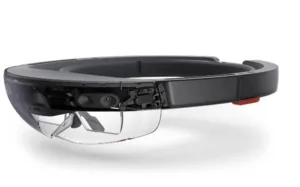By now, most technology analysts, writers and bloggers have realized that Google Glass is no longer aiming at leading the charge of introducing augmented reality to the average consumer. Even with a revamped model, Google’s aim has shifted to the corporate and professional markets. What we are left with is the much anticipated Microsoft HoloLens device that is, more or less, clearly aiming at the consumer market.

Besides the love affair of science fiction movies with augmented and virtual reality display devices, real life applications are mainly limited to niche market applications. The technology is just entering helmet displays in fighter jets and surgical theaters, both highly specialized applications where money does not matter that much. Other applications for head mounted displays are in warehousing and maintenance. These are not highly specialized applications, but the application plays to the strength of the augmented reality smartglasses by providing information without interfering with the use of hands.
So, what is the key to enter mainstream consumer markets with any kind of head mounted display technology? First of all, if I really knew, I wouldn’t tell you. I would tell all the companies that so far have failed to make that connection. I guess Google would pay me a pretty penny by now to salvage its efforts. So just follow me on some speculation on why we may just not be ready to jump into the AR / VR frenzy as consumers.
By far the most compelling application so far is the use as a gaming device. Yes, we are talking about Oculus here. This was the application the Oculus team was shooting for, when Facebook made them an offer they couldn’t refuse. It is up to you if you believe that this did not change the team’s internal thinking and efforts to create a gaming device. I think it did derail them to a certain degree. Nevertheless, the remaining question is why it is taking them so long to develop a device that would be attractive to gamers?
First of all, a virtual reality headset will not work favorably with all type of games, and even with the ones that will work well, it will take some time to convince gamers that the experience is so much better than a large flat screen TV. This means that a VR headset will have to compete with a FHD TV or monitor that can be had for a few hundred dollars, even for the better brand names.
In the TV & monitor business, if brands ask for more money they better offer better performance. In terms of resolution, I have not seen anyone doing this in the consumer devices yet and with the trend to 4K TVs, the bar is even increasing – at least when it comes to resolution.
Source: Microsoft Hololens
Microsoft HoloLens on the other hand is showing solutions that may be of interest to the consumer, even though they say that the first devices coming out next year will address the professional market as well. This may be based on the price tag or even on the overall performance that Microsoft expects.
From recent Microsoft statements, you might expect that the consumer version of the HoloLens device will not arrive before 2020, putting it almost back into the science fiction category. Even then it will still not be clear if consumers will jump on the AR / VR bandwagon.
This brings us back to the question of what consumers will actually want in a head mounted display? So far the approach of all the companies involved was centered on either providing information or entertainment to the user. In all cases, the headset is clearly identifiable as an electronic device by other people around the user.
This is where Google ran into the social awkwardness issue that is considered to be the main reason for the slow uptake in the market. Of course, a $1,500 price tag didn’t help either. Interestingly, the issue was triggered more by the use of the included camera rather than the display functions.
Other companies like Sony, Vuzix, Epson, Zeiss, etc. have had similar experiences. People just don’t seem to be interested in looking like a Borg character out of Star Trek. As a consequence, all of them have tried to make the display less conspicuous to other people by streamlining the design and making them look like a cool pair of sunglasses. So far no one has succeeded.
Wait a minute… As far as success is concerned, Recon Instruments seems to have done well even before its acquisition by Intel. In this case, others can’t even tell if a Recon device is incorporated into a ski helmet or not. The social awkwardness factor seems to have disappeared and adoption rate among ski enthusiasts is good.
From a technology standpoint, at this time we are not able to create a headset that does not appear to be a piece of electronic hardware. Also they are easily identifiable by other people. Even when we are able to achieve this in a normal pair of glasses, we still have to wear the glasses. Wait, didn’t the 3D wave in the home just died off pretty much as a consequence of the resistance of consumers to wear glasses? (Yes, I know there are also some performance issues and lack of content to blame.)
From a content perspective, app development should not be a hurdle if the right hardware platform comes along. So, when will we have the right hardware platform available for the consumer? This is the question Microsoft hopes to have the answer to.
Looking at the device, it somehow does not really scream “streamlined design”. It actually looks more like a helmet than a pair of glasses. It will be interesting to see if this is the right approach to convince consumers to jump head first into the AR / VR world. (NH)

